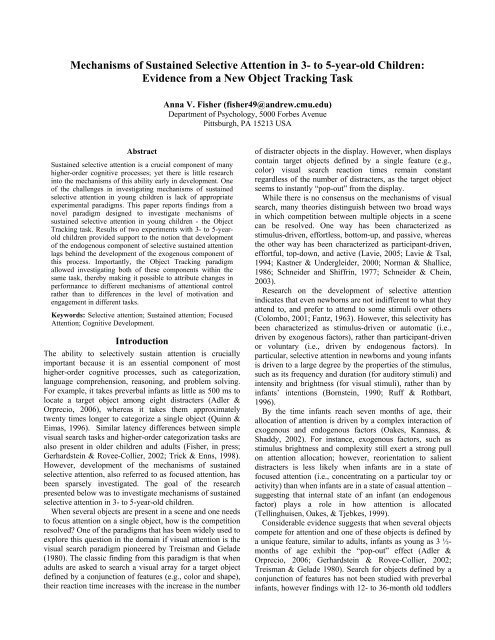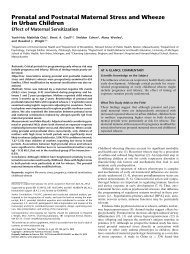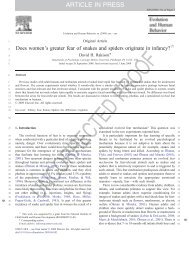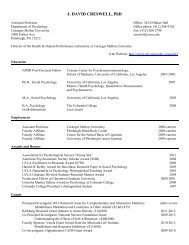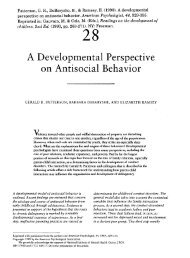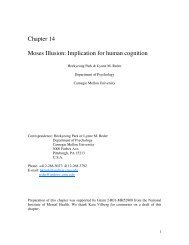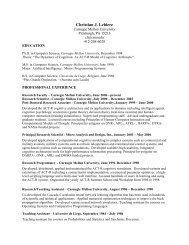Mechanisms of Sustained Selective Attention in 3- to 5 ... - Psychology
Mechanisms of Sustained Selective Attention in 3- to 5 ... - Psychology
Mechanisms of Sustained Selective Attention in 3- to 5 ... - Psychology
Create successful ePaper yourself
Turn your PDF publications into a flip-book with our unique Google optimized e-Paper software.
<strong>Mechanisms</strong> <strong>of</strong> <strong>Susta<strong>in</strong>ed</strong> <strong>Selective</strong> <strong>Attention</strong> <strong>in</strong> 3- <strong>to</strong> 5-year-old Children:<br />
Evidence from a New Object Track<strong>in</strong>g Task<br />
Abstract<br />
<strong>Susta<strong>in</strong>ed</strong> selective attention is a crucial component <strong>of</strong> many<br />
higher-order cognitive processes; yet there is little research<br />
<strong>in</strong><strong>to</strong> the mechanisms <strong>of</strong> this ability early <strong>in</strong> development. One<br />
<strong>of</strong> the challenges <strong>in</strong> <strong>in</strong>vestigat<strong>in</strong>g mechanisms <strong>of</strong> susta<strong>in</strong>ed<br />
selective attention <strong>in</strong> young children is lack <strong>of</strong> appropriate<br />
experimental paradigms. This paper reports f<strong>in</strong>d<strong>in</strong>gs from a<br />
novel paradigm designed <strong>to</strong> <strong>in</strong>vestigate mechanisms <strong>of</strong><br />
susta<strong>in</strong>ed selective attention <strong>in</strong> young children - the Object<br />
Track<strong>in</strong>g task. Results <strong>of</strong> two experiments with 3- <strong>to</strong> 5-yearold<br />
children provided support <strong>to</strong> the notion that development<br />
<strong>of</strong> the endogenous component <strong>of</strong> selective susta<strong>in</strong>ed attention<br />
lags beh<strong>in</strong>d the development <strong>of</strong> the exogenous component <strong>of</strong><br />
this process. Importantly, the Object Track<strong>in</strong>g paradigm<br />
allowed <strong>in</strong>vestigat<strong>in</strong>g both <strong>of</strong> these components with<strong>in</strong> the<br />
same task, thereby mak<strong>in</strong>g it possible <strong>to</strong> attribute changes <strong>in</strong><br />
performance <strong>to</strong> different mechanisms <strong>of</strong> attentional control<br />
rather than <strong>to</strong> differences <strong>in</strong> the level <strong>of</strong> motivation and<br />
engagement <strong>in</strong> different tasks.<br />
Keywords: <strong>Selective</strong> attention; <strong>Susta<strong>in</strong>ed</strong> attention; Focused<br />
<strong>Attention</strong>; Cognitive Development.<br />
Introduction<br />
The ability <strong>to</strong> selectively susta<strong>in</strong> attention is crucially<br />
important because it is an essential component <strong>of</strong> most<br />
higher-order cognitive processes, such as categorization,<br />
language comprehension, reason<strong>in</strong>g, and problem solv<strong>in</strong>g.<br />
For example, it takes preverbal <strong>in</strong>fants as little as 500 ms <strong>to</strong><br />
locate a target object among eight distracters (Adler &<br />
Orprecio, 2006), whereas it takes them approximately<br />
twenty times longer <strong>to</strong> categorize a s<strong>in</strong>gle object (Qu<strong>in</strong>n &<br />
Eimas, 1996). Similar latency differences between simple<br />
visual search tasks and higher-order categorization tasks are<br />
also present <strong>in</strong> older children and adults (Fisher, <strong>in</strong> press;<br />
Gerhardste<strong>in</strong> & Rovee-Collier, 2002; Trick & Enns, 1998).<br />
However, development <strong>of</strong> the mechanisms <strong>of</strong> susta<strong>in</strong>ed<br />
selective attention, also referred <strong>to</strong> as focused attention, has<br />
been sparsely <strong>in</strong>vestigated. The goal <strong>of</strong> the research<br />
presented below was <strong>to</strong> <strong>in</strong>vestigate mechanisms <strong>of</strong> susta<strong>in</strong>ed<br />
selective attention <strong>in</strong> 3- <strong>to</strong> 5-year-old children.<br />
When several objects are present <strong>in</strong> a scene and one needs<br />
<strong>to</strong> focus attention on a s<strong>in</strong>gle object, how is the competition<br />
resolved? One <strong>of</strong> the paradigms that has been widely used <strong>to</strong><br />
explore this question <strong>in</strong> the doma<strong>in</strong> if visual attention is the<br />
visual search paradigm pioneered by Treisman and Gelade<br />
(1980). The classic f<strong>in</strong>d<strong>in</strong>g from this paradigm is that when<br />
adults are asked <strong>to</strong> search a visual array for a target object<br />
def<strong>in</strong>ed by a conjunction <strong>of</strong> features (e.g., color and shape),<br />
their reaction time <strong>in</strong>creases with the <strong>in</strong>crease <strong>in</strong> the number<br />
Anna V. Fisher (fisher49@andrew.cmu.edu)<br />
Department <strong>of</strong> <strong>Psychology</strong>, 5000 Forbes Avenue<br />
Pittsburgh, PA 15213 USA<br />
<strong>of</strong> distracter objects <strong>in</strong> the display. However, when displays<br />
conta<strong>in</strong> target objects def<strong>in</strong>ed by a s<strong>in</strong>gle feature (e.g.,<br />
color) visual search reaction times rema<strong>in</strong> constant<br />
regardless <strong>of</strong> the number <strong>of</strong> distracters, as the target object<br />
seems <strong>to</strong> <strong>in</strong>stantly “pop-out” from the display.<br />
While there is no consensus on the mechanisms <strong>of</strong> visual<br />
search, many theories dist<strong>in</strong>guish between two broad ways<br />
<strong>in</strong> which competition between multiple objects <strong>in</strong> a scene<br />
can be resolved. One way has been characterized as<br />
stimulus-driven, effortless, bot<strong>to</strong>m-up, and passive, whereas<br />
the other way has been characterized as participant-driven,<br />
effortful, <strong>to</strong>p-down, and active (Lavie, 2005; Lavie & Tsal,<br />
1994; Kastner & Undergleider, 2000; Norman & Shallice,<br />
1986; Schneider and Shiffr<strong>in</strong>, 1977; Schneider & Che<strong>in</strong>,<br />
2003).<br />
Research on the development <strong>of</strong> selective attention<br />
<strong>in</strong>dicates that even newborns are not <strong>in</strong>different <strong>to</strong> what they<br />
attend <strong>to</strong>, and prefer <strong>to</strong> attend <strong>to</strong> some stimuli over others<br />
(Colombo, 2001; Fantz, 1963). However, this selectivity has<br />
been characterized as stimulus-driven or au<strong>to</strong>matic (i.e.,<br />
driven by exogenous fac<strong>to</strong>rs), rather than participant-driven<br />
or voluntary (i.e., driven by endogenous fac<strong>to</strong>rs). In<br />
particular, selective attention <strong>in</strong> newborns and young <strong>in</strong>fants<br />
is driven <strong>to</strong> a large degree by the properties <strong>of</strong> the stimulus,<br />
such as its frequency and duration (for audi<strong>to</strong>ry stimuli) and<br />
<strong>in</strong>tensity and brightness (for visual stimuli), rather than by<br />
<strong>in</strong>fants’ <strong>in</strong>tentions (Bornste<strong>in</strong>, 1990; Ruff & Rothbart,<br />
1996).<br />
By the time <strong>in</strong>fants reach seven months <strong>of</strong> age, their<br />
allocation <strong>of</strong> attention is driven by a complex <strong>in</strong>teraction <strong>of</strong><br />
exogenous and endogenous fac<strong>to</strong>rs (Oakes, Kannass, &<br />
Shaddy, 2002). For <strong>in</strong>stance, exogenous fac<strong>to</strong>rs, such as<br />
stimulus brightness and complexity still exert a strong pull<br />
on attention allocation; however, reorientation <strong>to</strong> salient<br />
distracters is less likely when <strong>in</strong>fants are <strong>in</strong> a state <strong>of</strong><br />
focused attention (i.e., concentrat<strong>in</strong>g on a particular <strong>to</strong>y or<br />
activity) than when <strong>in</strong>fants are <strong>in</strong> a state <strong>of</strong> casual attention –<br />
suggest<strong>in</strong>g that <strong>in</strong>ternal state <strong>of</strong> an <strong>in</strong>fant (an endogenous<br />
fac<strong>to</strong>r) plays a role <strong>in</strong> how attention is allocated<br />
(Tell<strong>in</strong>ghuisen, Oakes, & Tjebkes, 1999).<br />
Considerable evidence suggests that when several objects<br />
compete for attention and one <strong>of</strong> these objects is def<strong>in</strong>ed by<br />
a unique feature, similar <strong>to</strong> adults, <strong>in</strong>fants as young as 3 ½-<br />
months <strong>of</strong> age exhibit the “pop-out” effect (Adler &<br />
Orprecio, 2006; Gerhardste<strong>in</strong> & Rovee-Collier, 2002;<br />
Treisman & Gelade 1980). Search for objects def<strong>in</strong>ed by a<br />
conjunction <strong>of</strong> features has not been studied with preverbal<br />
<strong>in</strong>fants, however f<strong>in</strong>d<strong>in</strong>gs with 12- <strong>to</strong> 36-month old <strong>to</strong>ddlers
<strong>in</strong>dicate that their response latency <strong>in</strong>creases with <strong>in</strong>creased<br />
number <strong>of</strong> distracters <strong>in</strong> the display – a pattern that is similar<br />
<strong>to</strong> that <strong>in</strong> adults (Gerhardste<strong>in</strong> & Rovee-Collier, 2002;<br />
Scerif, Cornish, Wild<strong>in</strong>g, Driver, & Karmil<strong>of</strong>f-Smith, 2004;<br />
Treisman & Gelade 1980). Despite considerable quantitative<br />
differences <strong>in</strong> performance <strong>of</strong> children and adults persist<strong>in</strong>g<br />
until at least until ten years <strong>of</strong> age (Trick & Enns, 1998), the<br />
qualitative pattern <strong>of</strong> results from the visual search tasks<br />
with young children is similar <strong>to</strong> that <strong>of</strong> adults.<br />
However, higher-order cognitive processes (such as<br />
categorization, language comprehension, and reason<strong>in</strong>g<br />
among many others) impose greater demands on attention<br />
than simply select<strong>in</strong>g an object for process<strong>in</strong>g. One <strong>of</strong> these<br />
demands is susta<strong>in</strong><strong>in</strong>g attention <strong>to</strong> the selected object for at<br />
least brief periods <strong>of</strong> time. Development <strong>of</strong> this ability has<br />
been <strong>of</strong>ten exam<strong>in</strong>ed <strong>in</strong> natural sett<strong>in</strong>gs (such as free play)<br />
<strong>in</strong> prior research as well as computerized vigilance-type<br />
tasks (Oakes, Kannass, & Shaddy, 2002; Ruff & Lawson,<br />
1990; Sarid & Breznitz, 1997; Tell<strong>in</strong>ghuisen, Oakes, &<br />
Tjebkes, 1999). These studies <strong>in</strong>dicate dramatic<br />
improvements <strong>in</strong> this ability between 12 months and six<br />
years <strong>of</strong> age. For example, studies utiliz<strong>in</strong>g the context <strong>of</strong><br />
free play suggest that duration <strong>of</strong> focused free play <strong>in</strong>creases<br />
from approximately four m<strong>in</strong>utes <strong>in</strong> 2- and 3-year-old<br />
children <strong>to</strong> over n<strong>in</strong>e m<strong>in</strong>utes <strong>in</strong> 5- and 6-year-olds (Ruff &<br />
Lawson, 1990; Sarid & Breznitz, 1997). Furthermore, these<br />
studies <strong>in</strong>dicate that older children are markedly less<br />
distractible than younger children, and also more likely <strong>to</strong><br />
return <strong>to</strong> an <strong>in</strong>terrupted activity.<br />
Another k<strong>in</strong>d <strong>of</strong> paradigm that has been successfully used<br />
<strong>to</strong> <strong>in</strong>vestigate susta<strong>in</strong>ed selective attention <strong>in</strong> young children<br />
is a Cont<strong>in</strong>uous Performance Test – a vigilance-type task<br />
modeled after tests used with adults (Warm & Jerison,<br />
1984). In this task participants are asked <strong>to</strong> attend <strong>to</strong> a<br />
stream <strong>of</strong> visual stimuli and <strong>to</strong> respond <strong>to</strong> a target stimulus<br />
while withhold<strong>in</strong>g response <strong>to</strong> non-target stimuli. For<br />
example, participants might be presented with a series <strong>of</strong><br />
images depict<strong>in</strong>g ducks and turtles, and <strong>in</strong>structed <strong>to</strong> press a<br />
but<strong>to</strong>n every time they see a duck and avoid press<strong>in</strong>g the<br />
but<strong>to</strong>n when they see turtles (Akshoom<strong>of</strong>f, 2002). The goal<br />
<strong>of</strong> this task is <strong>to</strong> <strong>in</strong>vestigate whether participants can rema<strong>in</strong><br />
alert for prolonged periods <strong>of</strong> time (e.g., 5- <strong>to</strong> 9-m<strong>in</strong>ute<br />
<strong>in</strong>tervals) and accurately detect <strong>in</strong>frequently appear<strong>in</strong>g<br />
target objects. A typical f<strong>in</strong>d<strong>in</strong>g <strong>of</strong> such studies is that<br />
approximately 50% <strong>of</strong> 3 ½-year-old children fail <strong>to</strong><br />
complete this task, <strong>in</strong>dicat<strong>in</strong>g difficulty <strong>in</strong> susta<strong>in</strong><strong>in</strong>g their<br />
attention (Akshoom<strong>of</strong>f, 2002; Corkum, Byrne, & Ellsworth,<br />
1995). Those 3-year-olds who can complete the task (thus<br />
demonstrat<strong>in</strong>g their ability <strong>to</strong> ma<strong>in</strong>ta<strong>in</strong> attention for<br />
prolonged periods <strong>of</strong> time) exhibit high rates <strong>of</strong> both misses<br />
and false alarms, suggest<strong>in</strong>g difficulty with the voluntary<br />
control <strong>of</strong> selectivity. Marked improvement on this task (<strong>in</strong><br />
terms <strong>of</strong> proportion <strong>of</strong> children complet<strong>in</strong>g the task,<br />
response time, and accuracy) is observed between four and<br />
five years <strong>of</strong> age.<br />
Studies <strong>of</strong> susta<strong>in</strong>ed selective attention <strong>in</strong> the context <strong>of</strong><br />
free play and vigilance-type tasks provide valuable <strong>in</strong>sights<br />
regard<strong>in</strong>g the miles<strong>to</strong>nes <strong>in</strong> the development <strong>of</strong> this<br />
important ability. However, these studies are limited <strong>in</strong><br />
their ability <strong>to</strong> assess the mechanisms <strong>of</strong> susta<strong>in</strong>ed selective<br />
attention <strong>in</strong> young children and changes <strong>in</strong> these<br />
mechanisms <strong>in</strong> the course <strong>of</strong> development. One <strong>of</strong> the<br />
challenges <strong>in</strong> <strong>in</strong>vestigat<strong>in</strong>g this question stems from the lack<br />
<strong>of</strong> appropriate experimental paradigms. For example, it has<br />
been argued that differences <strong>in</strong> the level <strong>of</strong> performance on<br />
exist<strong>in</strong>g tasks <strong>of</strong> focused attention between younger and<br />
older children may arise as a result <strong>of</strong> differential levels <strong>of</strong><br />
motivation and engagement <strong>in</strong> the task rater than<br />
developmental changes <strong>in</strong> mechanisms <strong>of</strong> attentional control<br />
(Ruff & Rothbart, 1996). Furthermore, there is currently no<br />
task that makes it possible <strong>to</strong> assess contribution <strong>of</strong><br />
exogenous and endogenous fac<strong>to</strong>rs <strong>to</strong> selective susta<strong>in</strong>ed<br />
attention with<strong>in</strong> the same task, thus mak<strong>in</strong>g it difficult <strong>to</strong><br />
uniquely attribute changes <strong>in</strong> performance <strong>to</strong> different<br />
attentional mechanisms rather than <strong>to</strong> task-specific fac<strong>to</strong>rs.<br />
The goal <strong>of</strong> the present research was <strong>to</strong> develop a task<br />
suitable for <strong>in</strong>vestigation <strong>of</strong> the mechanisms <strong>of</strong> susta<strong>in</strong>ed<br />
selective attention <strong>in</strong> young children, and <strong>to</strong> use this task <strong>to</strong><br />
<strong>in</strong>vestigate the contribution <strong>of</strong> exogenous and endogenous<br />
fac<strong>to</strong>rs <strong>to</strong> susta<strong>in</strong>ed selective attention <strong>in</strong> 3- <strong>to</strong> 5-year-old<br />
children.<br />
The Object Track<strong>in</strong>g Task<br />
The Object Track<strong>in</strong>g task is rem<strong>in</strong>iscent <strong>of</strong> the Multiple<br />
Object Track<strong>in</strong>g (MOT) task used with adults <strong>to</strong> study<br />
properties <strong>of</strong> visual attention (Pylyshyn & S<strong>to</strong>rm, 1988;<br />
Yantis, 1992). In the MOT task participants are asked <strong>to</strong><br />
visually track several identical target objects mov<strong>in</strong>g along<br />
random trajec<strong>to</strong>ries among a larger set <strong>of</strong> identical objects,<br />
also mov<strong>in</strong>g along random trajec<strong>to</strong>ries. In this paradigm<br />
target objects are dist<strong>in</strong>ct only at the beg<strong>in</strong>n<strong>in</strong>g <strong>of</strong> each trial<br />
(all target objects pulsate for a brief period <strong>of</strong> time at the<br />
onset <strong>of</strong> each trial), however adult participants (<strong>of</strong>ten <strong>to</strong><br />
their own surprise) are capable <strong>of</strong> track<strong>in</strong>g four targets <strong>in</strong> the<br />
field <strong>of</strong> eights distracters with accuracy approach<strong>in</strong>g 90%<br />
(Pylyshyn & S<strong>to</strong>rm, 1988). While this paradigm has been<br />
successfully used <strong>to</strong> <strong>in</strong>vestigate properties <strong>of</strong> object-based<br />
attention <strong>in</strong> adults for over twenty years, our pilot test<strong>in</strong>g<br />
suggested that the task is prohibitively complex for young<br />
children. Furthermore, the MOT paradigm does not allow<br />
assessment <strong>of</strong> au<strong>to</strong>matic and voluntary components <strong>of</strong><br />
susta<strong>in</strong>ed selective attention with<strong>in</strong> the same task. The new<br />
Object Track<strong>in</strong>g task was created specifically <strong>to</strong> <strong>in</strong>vestigate<br />
mechanisms <strong>of</strong> susta<strong>in</strong>ed selective attention with young<br />
children.<br />
In the Object Track<strong>in</strong>g task participants are presented<br />
with a three by three grid, with each <strong>of</strong> the n<strong>in</strong>e grid<br />
locations identified by a popular Disney character, and a<br />
target object mov<strong>in</strong>g on the grid along a random trajec<strong>to</strong>ry.<br />
Participants are asked <strong>to</strong> visually track the target and<br />
identify the grid location last visited by the target before it<br />
disappears. The mov<strong>in</strong>g target <strong>in</strong> this task can be<br />
accompanied by zero <strong>to</strong> eight distracters, also mov<strong>in</strong>g along<br />
a random trajec<strong>to</strong>ry. Target and distracter objects are<br />
randomly selected on each trial from a pool <strong>of</strong> n<strong>in</strong>e different
geometric shapes. At the beg<strong>in</strong>n<strong>in</strong>g <strong>of</strong> each trial participants<br />
are presented with still objects, and the object designated as<br />
the target is clearly marked at the beg<strong>in</strong>n<strong>in</strong>g <strong>of</strong> each trial by<br />
be<strong>in</strong>g encircled <strong>in</strong> red (see Figure 1 for a schematic<br />
depiction <strong>of</strong> the task).<br />
There are no restrictions on the motion paths <strong>of</strong> distracter<br />
objects, but there are two restrictions on the motion paths <strong>of</strong><br />
the target objects. First, the target object has <strong>to</strong> disappear <strong>in</strong><br />
the middle <strong>of</strong> one <strong>of</strong> the n<strong>in</strong>e cells <strong>to</strong> reduce possible<br />
confusion if the target diapers on the border <strong>of</strong> two or more<br />
cells. Second, the target object must visit all n<strong>in</strong>e screen<br />
locations at least once before disappear<strong>in</strong>g. In all the<br />
experiments presented below, the speed <strong>of</strong> motion for all<br />
target and distracter objects was set at 800 pixels per frame<br />
at 30 frames per second (this speed was chosen dur<strong>in</strong>g pilot<br />
test<strong>in</strong>g with a separate group <strong>of</strong> 3- <strong>to</strong> 5-year-old children).<br />
Average trial duration was approximately 11 sec (a more<br />
detailed description <strong>of</strong> trial duration is provides <strong>in</strong> the<br />
Methods section).<br />
When presented with the task, participants are expla<strong>in</strong>ed<br />
that (1) objects will start mov<strong>in</strong>g when the experimenter<br />
pushes a but<strong>to</strong>n, (2) the goal <strong>of</strong> the task is <strong>to</strong> watch the<br />
object encircled <strong>in</strong> red, (3) the red circle will disappear as<br />
soon as objects start mov<strong>in</strong>g, and (4) once all objects<br />
disappear from the screen participants will need <strong>to</strong> po<strong>in</strong>t <strong>to</strong><br />
the grid location last visited by the target object. Notice, that<br />
participants are not asked <strong>to</strong> perform visual search s<strong>in</strong>ce the<br />
target is clearly marked at the beg<strong>in</strong>n<strong>in</strong>g <strong>of</strong> each trial.<br />
Figure 1. Schematic depiction <strong>of</strong> the Object Track<strong>in</strong>g task.<br />
It has been demonstrated that salient objects engage<br />
attention au<strong>to</strong>matically, whereas less salient objects may<br />
require voluntary process<strong>in</strong>g (Koch & Ullman, 1985; Smith,<br />
et. al., 1996; Trick & Enns, 1998; Underwood, et. al., 2006).<br />
Therefore, distracter manipulations <strong>in</strong> the Object Track<strong>in</strong>g<br />
task can allow assessment <strong>of</strong> the contribution <strong>of</strong> exogenous<br />
and endogenous fac<strong>to</strong>rs <strong>to</strong> selective susta<strong>in</strong>ed attention <strong>in</strong><br />
the visual doma<strong>in</strong>. In particular, it is expected that target<br />
objects will be more salient when distracters are identical <strong>to</strong><br />
each other and different from the target (All Same<br />
Distracters condition) than when distracter objects are<br />
different from the target and from each other (All Different<br />
Distracters condition) (Treisman & Gelade, 1980). Thus,<br />
track<strong>in</strong>g accuracy <strong>in</strong> the All Different Distracters condition<br />
will reflect the contribution <strong>of</strong> predom<strong>in</strong>antly endogenous<br />
fac<strong>to</strong>rs, whereas track<strong>in</strong>g accuracy <strong>in</strong> the All Same<br />
Distracters condition will reflect the contribution <strong>of</strong> both<br />
exogenous and endogenous fac<strong>to</strong>rs. The difference <strong>in</strong><br />
performance between these conditions will be reflective <strong>of</strong><br />
the unique contribution <strong>of</strong> exogenous attention. Experiment<br />
1 <strong>in</strong>vestigated mechanisms <strong>of</strong> susta<strong>in</strong>ed selective attention<br />
<strong>in</strong> 3- <strong>to</strong> 5-year-old children us<strong>in</strong>g the Object Track<strong>in</strong>g task<br />
<strong>in</strong> which target objects were accompanied by two<br />
distracters, and Experiment 2 <strong>in</strong>vestigated performance with<br />
six distracters.<br />
Experiment 1<br />
Method<br />
Participants<br />
Participants were 15 3-year-old children (M = 3.66 years,<br />
SD = .28 years; 5 females and 10 males), 17 4-year-old<br />
children (M = 4.49 years, SD = .25 years; 5 females and 12<br />
males), and 18 5-year-old children (M = 5.23 years, SD =<br />
.23 years; 7 females and 11 males).<br />
Design and Procedure<br />
There were two with<strong>in</strong>-subject conditions <strong>in</strong> Experiment 1:<br />
All Same Distracters and All Different Distracters<br />
condition. The order <strong>of</strong> these two conditions was<br />
counterbalanced across participants; both conditions were<br />
completed on two separate test<strong>in</strong>g sessions that were spaced<br />
one <strong>to</strong> two weeks apart.<br />
As described <strong>in</strong> the <strong>in</strong>troduction, the Object Track<strong>in</strong>g task<br />
is designed such that the target objects have <strong>to</strong> appear at<br />
least once <strong>in</strong> each <strong>of</strong> the n<strong>in</strong>e on-screen locations and<br />
disappear <strong>in</strong> the middle <strong>of</strong> one <strong>of</strong> these locations. Due <strong>to</strong><br />
these restrictions, trial duration is not fixed but varies<br />
slightly from trial <strong>to</strong> trial. In Experiment 1, m<strong>in</strong>imum trial<br />
duration was set <strong>to</strong> 10 s and mean trial duration was 11.00 s<br />
(SD = 0.95 s) <strong>in</strong> the All Same condition and 10.98 s (SD =<br />
1.03 s) <strong>in</strong> the All Different condition.<br />
To control for the possibility that any observed<br />
differences <strong>in</strong> track<strong>in</strong>g accuracy may stem from children<br />
be<strong>in</strong>g more likely <strong>to</strong> remember what object they were<br />
supposed <strong>to</strong> track <strong>in</strong> the All Same Distracters condition than<br />
<strong>in</strong> the All Different Distracters condition, at the end <strong>of</strong> each<br />
trial participants were asked <strong>to</strong> identify which object served<br />
as target on the trial they had just completed. Children were<br />
presented with a card depict<strong>in</strong>g all n<strong>in</strong>e shapes that could<br />
serve as target objects <strong>in</strong> this task, and asked <strong>to</strong> po<strong>in</strong>t <strong>to</strong> the<br />
shape they had been track<strong>in</strong>g.<br />
All participants were tested by hypothesis-bl<strong>in</strong>d<br />
experimenters <strong>in</strong> quiet rooms <strong>in</strong> their day care centers.<br />
Participants completed 11 trials <strong>of</strong> the Object Track<strong>in</strong>g task<br />
<strong>in</strong> each condition. The first trial was completed with<br />
assistance from the experimenter who traced the mov<strong>in</strong>g<br />
target with their <strong>in</strong>dex f<strong>in</strong>ger. Participants were then<br />
expla<strong>in</strong>ed that they needed <strong>to</strong> complete the rest <strong>of</strong> the task<br />
by themselves, track<strong>in</strong>g the target objects only with their
eyes. Data from the first experimenter-assisted trial were<br />
discarded from the analyses.<br />
Results<br />
Memory Accuracy<br />
Memory accuracy data are presented <strong>in</strong> Table 1. Memory<br />
scores were submitted <strong>to</strong> a mixed ANOVA with age as a<br />
between-subject fac<strong>to</strong>r and condition (All Same vs. All<br />
Different) as a with<strong>in</strong>-subject fac<strong>to</strong>r. This analysis <strong>in</strong>dicated<br />
a ma<strong>in</strong> effect <strong>of</strong> age, F (2, 47) = 5.77, p < .01, η2 = .20.<br />
Post-hoc Tukey HSD tests <strong>in</strong>dicated that overall memory<br />
accuracy was lower <strong>in</strong> 3-year-old children (M = .67) than <strong>in</strong><br />
both older age groups (p < .05), and statistically equivalent<br />
<strong>in</strong> 4- and 5-year-old children (M = .83 and M = .86,<br />
respectively). Most importantly however, there was no<br />
effect <strong>of</strong> condition and no age-by-condition <strong>in</strong>teraction, both<br />
Fs < 1, ns. Therefore, results <strong>of</strong> the memory check <strong>in</strong>dicate<br />
that if any significant differences <strong>in</strong> performance are<br />
observed between the All Same and the All Different<br />
Distracters conditions, these differences are unlikely <strong>to</strong> stem<br />
from differential demands on work<strong>in</strong>g memory.<br />
Table 1: Memory accuracy <strong>in</strong> Experiments 1-2 (standard<br />
deviations <strong>in</strong> parentheses).<br />
All Same<br />
Distracters<br />
All Different<br />
Distracters<br />
t-test<br />
p-values<br />
Experiment 1 (2 Distracters)<br />
3-y.o. .69 (.22) .65 (.22) p > .53<br />
4-y.o. .83 (.17) .83 (.17) p > .83<br />
5-y.o. .86 (.13) .86 (.22) p > .95<br />
Experiment 2 (6 Distracters)<br />
3-y.o. .47 (.31) .44 (.39) p > .75<br />
4-y.o. .75 (.29) .73 (.29) p > .83<br />
5-y.o. .79 (.19) .85 (.2) p > .44<br />
Object Track<strong>in</strong>g Accuracy<br />
Track<strong>in</strong>g accuracy scores were averaged across 10 trials for<br />
each participant and submitted <strong>to</strong> a mixed ANOVA with<br />
experimental condition (All Same and All Different<br />
Distracters) as a with<strong>in</strong>-subject fac<strong>to</strong>r and age (3-, 4-, and 5years<br />
<strong>of</strong> age) as a between-subject fac<strong>to</strong>r. Results <strong>of</strong> this<br />
analysis revealed a ma<strong>in</strong> effect <strong>of</strong> experimental condition,<br />
F(1, 47) = 11.46, p < .002, η2 = .19 and age F (2, 47) =<br />
8.04, p < .002, η2 = .25. These ma<strong>in</strong> effects were qualified<br />
by an age by condition <strong>in</strong>teraction, F (2, 47) = 3.43, p < .05,<br />
η2 = .13.<br />
Planned comparisons <strong>in</strong>dicated that participants <strong>in</strong> all<br />
conditions <strong>in</strong> all age groups identified the f<strong>in</strong>al location <strong>of</strong><br />
the target object at above chance level (chance = 11% given<br />
n<strong>in</strong>e response options), all one-sample ts > 5.85, ps < .0001.<br />
Five-year-old children were equally accurate <strong>in</strong> both<br />
conditions (83% and 84% <strong>of</strong> correct <strong>in</strong> the All Same and All<br />
Different condition, respectively) paired-sample t (17) < 1,<br />
ns. However, younger children exhibited higher track<strong>in</strong>g<br />
accuracy <strong>in</strong> the All Same than <strong>in</strong> the All Different condition<br />
(see Figure 2): 4-year-olds averaged 76% and 65% <strong>of</strong><br />
correct responses, respectively, paired-sample t (16) = 2.26,<br />
p < .05, Cohen’s d = .57; and 3-year-olds averaged 67% and<br />
48% <strong>of</strong> correct responses, respectively, paired-sample t (14)<br />
= 2.63, p < .05, Cohen’s d = .77.<br />
Figure 2. Track<strong>in</strong>g accuracy scores <strong>in</strong> Experiment 1.<br />
Overall, results <strong>of</strong> Experiment 1 suggest that the ability <strong>to</strong><br />
accurately track an object amidst heterogeneous distracters<br />
shows more protracted development than the ability <strong>to</strong><br />
accurately track an object amidst homogenous distracters.<br />
Notice however, that 5 year-old children <strong>in</strong> Experiment 1<br />
exhibited no effect <strong>of</strong> condition on track<strong>in</strong>g accuracy. At the<br />
same time, it has been shown that voluntary control <strong>of</strong><br />
attention cont<strong>in</strong>ues <strong>to</strong> mature well beyond the preschool<br />
years (Casey, Tottenham, & Fossella, 202; Trick & Enns,<br />
1998). It is possible therefore, that condition differences <strong>in</strong><br />
track<strong>in</strong>g accuracy will emerge <strong>in</strong> 5-year-old children if the<br />
task difficulty is <strong>in</strong>creased (e.g., by <strong>in</strong>creas<strong>in</strong>g the number <strong>of</strong><br />
distracters <strong>in</strong> the task). This possibility was <strong>in</strong>vestigated <strong>in</strong><br />
Experiment 2.<br />
Experiment 2<br />
Method<br />
Participants<br />
Participants were 15 3-year-old children (M = 3.33 years,<br />
SD = .27 years; 6 females and 9 males), 16 4-year-old<br />
children (M = 4.41 years, SD = .32 years; 8 females and 8<br />
males), and 20 5-year-old children (M = 5.33 years, SD =<br />
.37 years; 11 females and 9 males).<br />
Design and Procedure<br />
Design and procedure <strong>of</strong> Experiment 2 were identical <strong>to</strong> that<br />
<strong>of</strong> Experiment 1 with one important exception: the number<br />
<strong>of</strong> distracter objects was <strong>in</strong>creased <strong>to</strong> six (compared <strong>to</strong> two<br />
distracters <strong>in</strong> Experiment 1). Mean trial duration was 11.00s
(SD = .94s) <strong>in</strong> the All Same condition and 10.92s (SD =<br />
.86s) <strong>in</strong> the All Different condition.<br />
Results<br />
Memory Accuracy<br />
Memory accuracy data are presented <strong>in</strong> Table 1. Memory<br />
scores were submitted <strong>to</strong> a mixed ANOVA with age as a<br />
between-subject fac<strong>to</strong>r and condition (All Same vs. All<br />
Different) as a with<strong>in</strong>-subject fac<strong>to</strong>r. The analysis <strong>in</strong>dicated<br />
a ma<strong>in</strong> effect <strong>of</strong> age, F (2, 48) = 11.08, p < .0001, η2 = .33.<br />
Post-hoc Tukey HSD tests <strong>in</strong>dicated that overall memory<br />
accuracy <strong>in</strong> 3-year-old children (M = .45) was lower than <strong>in</strong><br />
older children (p < .05), and statistically equivalent <strong>in</strong> 4- and<br />
5-year-old children (M = .74 and M = .82, respectively).<br />
Similar <strong>to</strong> experiment 1, there was no effect <strong>of</strong> condition<br />
and no age-by-condition <strong>in</strong>teraction, both Fs < 1, ns.<br />
Object Track<strong>in</strong>g Accuracy<br />
Track<strong>in</strong>g accuracy scores were submitted <strong>to</strong> a mixed<br />
ANOVA with experimental condition (All Same and All<br />
Different) as a with<strong>in</strong>-subject fac<strong>to</strong>r and age (3-, 4-, and 5years<br />
<strong>of</strong> age) as a between-subject fac<strong>to</strong>r. Results <strong>of</strong> this<br />
analysis revealed a ma<strong>in</strong> effect <strong>of</strong> experimental condition F<br />
(1, 48) = 23.40, p < .0001, η2 = .32, and a ma<strong>in</strong> effect <strong>of</strong> age<br />
F (2, 48) = 8.93, p < .005, η2 = .27. Unlike Experiment 1,<br />
the age by condition <strong>in</strong>teraction did not reach significance,<br />
F (2, 48) < 1, ns.<br />
Figure 2. Track<strong>in</strong>g accuracy <strong>in</strong> Experiment 2.<br />
Similar <strong>to</strong> Experiment 1, participants <strong>in</strong> all conditions <strong>in</strong><br />
all three age groups identified the f<strong>in</strong>al location <strong>of</strong> the target<br />
object at above chance level (chance = 11%), all one-sample<br />
ts > 2.44, ps < .03. However, unlike Experiment 1, 5-yearold<br />
children exhibited the effect <strong>of</strong> condition with higher<br />
accuracy <strong>in</strong> the All Same condition (66%) than <strong>in</strong> the All<br />
Different condition (55%), paired-sample t (19)= 2.52, p <<br />
.05, Cohen’s d=.35. Similarly, 4-year old children exhibited<br />
higher accuracy <strong>in</strong> the All Same condition compared <strong>to</strong> the<br />
All Different condition (60% and 39%, respectively),<br />
paired-sample t (15)= 3.71, p < .005, Cohen’s d=.97, as did<br />
3-year-old children (34% and 20%, respectively), pairedsample<br />
t (14)= 2.07, p = .05, Cohen’s d =.69.<br />
Across the two experiments, it is appears that overall level<br />
<strong>of</strong> performance <strong>in</strong> all three age groups was lower <strong>in</strong><br />
Experiment 2, when six distracters were present, than <strong>in</strong><br />
Experiment 1, when two distracters were present. Indeed,<br />
when the data from both experiments were submitted <strong>to</strong> a<br />
mixed ANOVA with age and number <strong>of</strong> distracters (two vs.<br />
six) as between-subject fac<strong>to</strong>rs and type <strong>of</strong> distracters (All<br />
Same vs. All Different) as a with<strong>in</strong>-subject fac<strong>to</strong>r, the<br />
analysis revealed a ma<strong>in</strong> effect <strong>of</strong> the number <strong>of</strong> distracters,<br />
F (1, 95) = 34.09, p < .0001. This ma<strong>in</strong> effect was qualified<br />
by the distracter number by distracter type <strong>in</strong>teraction, F (1,<br />
95) = 33.88, p < .0001, suggest<strong>in</strong>g that decrease <strong>in</strong> accuracy<br />
with the <strong>in</strong>crease <strong>in</strong> the number <strong>of</strong> distracters was greater <strong>in</strong><br />
the All Different condition than <strong>in</strong> the All Same condition<br />
(mean decrease <strong>in</strong> accuracy across all age group was 27%<br />
and 22%, respectively).<br />
General Discussion<br />
This paper presents f<strong>in</strong>d<strong>in</strong>gs from a novel task <strong>in</strong> which<br />
children were asked <strong>to</strong> track a mov<strong>in</strong>g target object<br />
accompanied by distracters that varied <strong>in</strong> type (all same<br />
versus all different) and number (two versus six). The<br />
results po<strong>in</strong>ted <strong>to</strong> several novel f<strong>in</strong>d<strong>in</strong>gs. First, track<strong>in</strong>g<br />
accuracy improved with age. Second, track<strong>in</strong>g accuracy was<br />
higher <strong>in</strong> the All Same Distracters condition than <strong>in</strong> the All<br />
Different Distracters condition for all age groups when<br />
target objects were accompanied by six distracters; a similar<br />
difference between conditions was observed <strong>in</strong> 3- and 4year-old<br />
children when targets were accompanied by two<br />
distracters. Third, unlike the visual search tasks, <strong>in</strong>crease <strong>in</strong><br />
the number <strong>of</strong> homogenous distracters resulted <strong>in</strong> lower<br />
accuracy for all three age groups tested <strong>in</strong> this study.<br />
F<strong>in</strong>ally, there was no effect distracter type on children’s<br />
ability <strong>to</strong> remember which object they were supposed <strong>to</strong><br />
track; therefore, effects reported <strong>in</strong> this paper can not be<br />
attributed <strong>to</strong> differences <strong>in</strong> memory demands <strong>in</strong> different<br />
conditions.<br />
The central f<strong>in</strong>d<strong>in</strong>g reported <strong>in</strong> this paper is that<br />
preschool-age children are more successful at track<strong>in</strong>g<br />
targets mov<strong>in</strong>g among homogeneous than among<br />
heterogeneous distracters. This pattern <strong>of</strong> performance may<br />
arise for two different reasons. Consistent with the notion<br />
that the speed <strong>of</strong> engag<strong>in</strong>g attention (or attention-gett<strong>in</strong>g)<br />
and speed <strong>of</strong> releas<strong>in</strong>g attention (or attention-hold<strong>in</strong>g) are<br />
separate fac<strong>to</strong>rs (Cohen, 1972), one possibility is that<br />
homogeneous distracters provide less competition for<br />
attentional resources and therefore children are less likely <strong>to</strong><br />
glance away from the target mov<strong>in</strong>g amidst identical<br />
distracters. In other words, low competition for attentional<br />
resources may enhance attention-hold<strong>in</strong>g properties <strong>of</strong> the<br />
target. Alternatively, it is possible that children are equally<br />
likely <strong>to</strong> glance away from the target regardless <strong>of</strong> the type<br />
<strong>of</strong> distracters; however children are more successful <strong>in</strong><br />
locat<strong>in</strong>g the target after glanc<strong>in</strong>g away <strong>in</strong> the homogeneous<br />
than <strong>in</strong> the heterogeneous distracter condition. In other<br />
words, low competition for attentional resources may
enhance attention-gett<strong>in</strong>g properties <strong>of</strong> the target. These<br />
possibilities rema<strong>in</strong> <strong>to</strong> be addressed <strong>in</strong> future research.<br />
Overall, f<strong>in</strong>d<strong>in</strong>gs presented above support the notion that<br />
development <strong>of</strong> endogenous attention (probed by the All<br />
Different Distracters condition) lags beh<strong>in</strong>d the<br />
development <strong>of</strong> exogenous attention (probed by the All<br />
Same Distracters condition). Importantly, the Object<br />
Track<strong>in</strong>g task makes it possible <strong>to</strong> assess both mechanisms<br />
with<strong>in</strong> the same paradigm and quantify this lag <strong>in</strong> terms <strong>of</strong><br />
the differences <strong>in</strong> track<strong>in</strong>g accuracy. Therefore, this new<br />
paradigm allows attribut<strong>in</strong>g changes <strong>in</strong> performance <strong>to</strong><br />
different mechanisms <strong>of</strong> attentional control rather than <strong>to</strong><br />
differences <strong>in</strong> the level <strong>of</strong> motivation and engagement <strong>in</strong><br />
different tasks.<br />
Acknowledgments<br />
I thank children, parents, teachers, and adm<strong>in</strong>istra<strong>to</strong>rs for<br />
their participation. This research was supported by NICHD<br />
though Grant 1RO3HD060086-01A1.<br />
References<br />
Adler, S.A., & Orprecio, J. (2006). The eyes have it: Visual<br />
pop-out <strong>in</strong> <strong>in</strong>fants and adults. Developmental Science, 9,<br />
189-206.<br />
Akshoom<strong>of</strong>f, N. A. (2002). <strong>Selective</strong> attention and active<br />
engagement <strong>in</strong> young children. Developmental<br />
Neuropsychology, 22, 625-642.<br />
Bornste<strong>in</strong>, M. H. (1990). <strong>Attention</strong> <strong>in</strong> <strong>in</strong>fancy and the<br />
prediction <strong>of</strong> cognitive capacities <strong>in</strong> childhood. In J. Enns<br />
(Ed.) Development <strong>of</strong> <strong>Attention</strong>: Research and Theory.<br />
Amsterdam: Elsevier.<br />
Casey, B.J., Tottenham, N., & Fossella, J. (2002). Cl<strong>in</strong>ical,<br />
imag<strong>in</strong>g, lesions, and genetic approaches <strong>to</strong>ward a model<br />
<strong>of</strong> cognitive control. Developmental Psychobiology, 40,<br />
237-.254.<br />
Cohen, L. B. (1972). <strong>Attention</strong>-gett<strong>in</strong>g and attention-hold<strong>in</strong>g<br />
processes <strong>of</strong> <strong>in</strong>fant visual preferences. Child<br />
Development, 43, 869–879.<br />
Colombo, J. (2001). The development <strong>of</strong> visual attention <strong>in</strong><br />
<strong>in</strong>fancy. Annual Review <strong>of</strong> <strong>Psychology</strong>, 52, 337-367.<br />
Corkum, V., Byrne, J. & Ellsworth, C. (1995) Cl<strong>in</strong>ical<br />
Assessment <strong>of</strong> <strong>Susta<strong>in</strong>ed</strong> <strong>Attention</strong> <strong>in</strong> Preschoolers. Child<br />
Neuropsychology, 1(1), 3-18.<br />
Culham, J. (2003). <strong>Attention</strong>-grabb<strong>in</strong>g motion <strong>in</strong> the human<br />
bra<strong>in</strong>. Neuron, 40, 451-452.<br />
Fantz, R.L. & Miranda, S. B. (1975). Newborn <strong>in</strong>fant<br />
attention <strong>to</strong> form and con<strong>to</strong>ur. Child Development, 46,<br />
224-228.<br />
Fisher, A.V. (<strong>in</strong> press). <strong>Mechanisms</strong> <strong>of</strong> Induction Early <strong>in</strong><br />
Development. In M. Banich & D. Caccamise (Eds.)<br />
Generalization <strong>of</strong> Knowledge: Multidiscipl<strong>in</strong>ary<br />
Perspectives. New York: <strong>Psychology</strong> Press.<br />
Gerhardste<strong>in</strong>, P., & Rovee-Collier, C. (2002). Visual search<br />
<strong>in</strong> <strong>in</strong>fants and very young children. Journal <strong>of</strong><br />
Experimental Child <strong>Psychology</strong>, 81, 194-215.<br />
Kannass, K.N., Oakes, L.M., & Shaddy, D.J. (2006). A<br />
longitud<strong>in</strong>al <strong>in</strong>vestigation <strong>of</strong> the development <strong>of</strong> attention<br />
and distractibility. Journal <strong>of</strong> Cognition and<br />
Development, 7, 381-409.<br />
Kastner S. & Ungerleider L.G. (2000). <strong>Mechanisms</strong> <strong>of</strong><br />
visual attention <strong>in</strong> the human cortex. Annual Review <strong>of</strong><br />
Neuroscience, 23, 315-341.<br />
Koch, C. & Ullman, S. (1985). Shifts <strong>in</strong> selective visual<br />
attention: Towards the underly<strong>in</strong>g neural circuitry.<br />
Human Neurobiology, 4, 219-227.<br />
Lavie, N. (2005). Distracted and confused? <strong>Selective</strong><br />
attention under load. Trends <strong>in</strong> Cognitive Sciences, 9, 75-<br />
82<br />
Lavie, N. & Tsal, Y. (1994). Perceptual load as a major<br />
determ<strong>in</strong>ant <strong>of</strong> the locus <strong>of</strong> selection <strong>in</strong> visual attention.<br />
Perception and Psychophysics, 56, 183-197.<br />
Norman, D. A. & Shallice, T. (1986). <strong>Attention</strong> <strong>to</strong> action:<br />
Willed and au<strong>to</strong>matic control <strong>of</strong> behaviour. In R.J.<br />
Davidson, G.E. Schwartz, & D. Shapiro (Eds.),<br />
Consciousness and self-regulation, Plenum Press.<br />
Pylyshyn, Z. W., & S<strong>to</strong>rm, R. W. (1988). Track<strong>in</strong>g multiple<br />
<strong>in</strong>dependent targets: Evidence for a parallel track<strong>in</strong>g<br />
mechanism. Spatial Vision, 3, 179-197.<br />
Qu<strong>in</strong>n, P. C. & Eimas, P. D. (1996). Perceptual cues that<br />
permit categorical differentiation <strong>of</strong> animal species by<br />
<strong>in</strong>fants, Journal <strong>of</strong> Experimental Child <strong>Psychology</strong>, 63,<br />
189–211.<br />
Ruff, A.H., & Lawson, K.R. (1990). Development <strong>of</strong><br />
susta<strong>in</strong>ed, focused attention <strong>in</strong> young children dur<strong>in</strong>g free<br />
play. Developmental <strong>Psychology</strong>, 26, 85-93.<br />
Ruff, H., & Rothbart, M. K. (1996). <strong>Attention</strong> <strong>in</strong> early<br />
development. New York: Oxford University Press.<br />
Sarid, M., & Breznitz, Z. (1997). Developmental aspects <strong>of</strong><br />
susta<strong>in</strong>ed attention among 2- <strong>to</strong> 6-year-old children.<br />
International Journal <strong>of</strong> Behavioral Development, 21,<br />
303-312.<br />
Scerif, G., Cornish, K., Wild<strong>in</strong>g, J., Driver, J., & Karmil<strong>of</strong>f-<br />
Smith, A. (2004). Visual search <strong>in</strong> typically develop<strong>in</strong>g<br />
<strong>to</strong>ddlers and <strong>to</strong>ddlers with Fragile X or Williams<br />
Syndrome. Developmental Science, 7, 116-130.<br />
Schneider, W. & Che<strong>in</strong>, J.M. (2003). Controlled and<br />
au<strong>to</strong>matic process<strong>in</strong>g: Behavior, theory, & biology.<br />
Cognitive Science, 27, 525-559.<br />
Schneider, W. and Shiffr<strong>in</strong>, R.M. (1977). Controlled and<br />
au<strong>to</strong>matic human <strong>in</strong>formation process<strong>in</strong>g: Detection,<br />
search, and attention. Psychological Review, 84, 1-66.<br />
Stechler, G., & Latz, E. (1966). Some observations on<br />
attention and arousal <strong>in</strong> the human <strong>in</strong>fant. Journal <strong>of</strong> the<br />
American Academy <strong>of</strong> Child <strong>Psychology</strong>, 5, 517-525.<br />
Treisman, A. M., & Gelade, G. (1980). A Feature<strong>in</strong>tegration<br />
theory <strong>of</strong> attention. Cognitive <strong>Psychology</strong>, 12,<br />
97-136.<br />
Trick, L.M. & Enns, J.T. (1998) Lifispan changes <strong>in</strong><br />
attention: The visual search task. Cognitive Development,<br />
13, 369-386.<br />
Warm, J.S., & Jerison, H. J. (1984). The psychophysics <strong>of</strong><br />
vigilance. In J.S. Warm (Ed.) <strong>Susta<strong>in</strong>ed</strong> attention <strong>in</strong><br />
human performance (pp. 15-59). Chichester, UK: Wiley.


